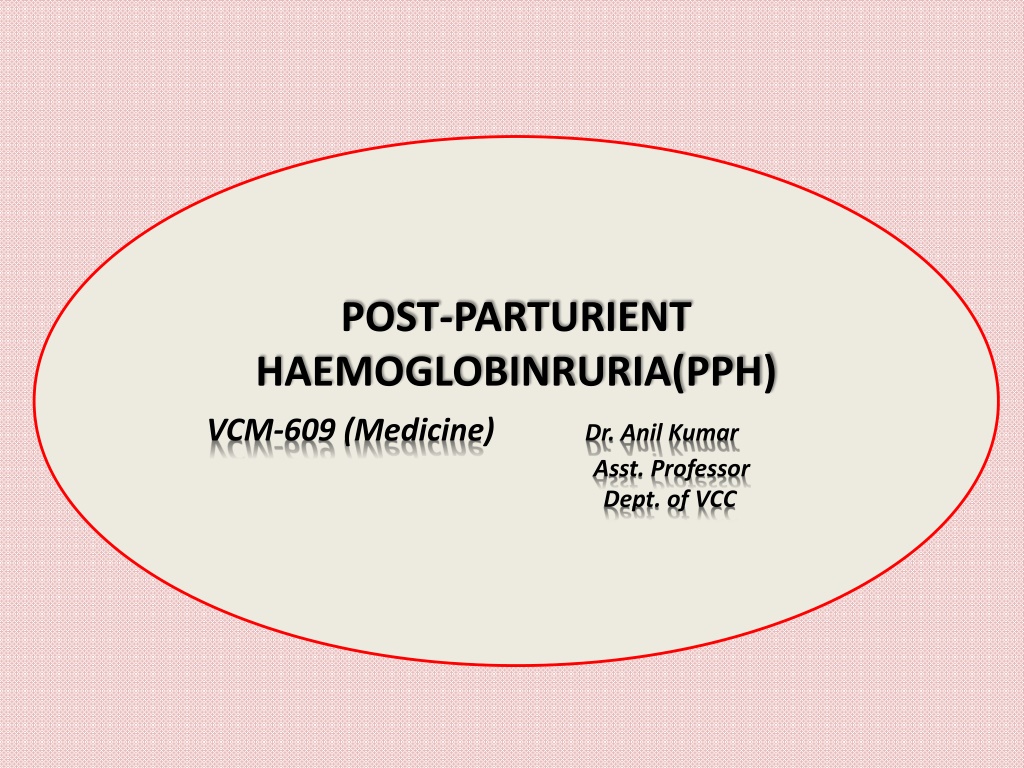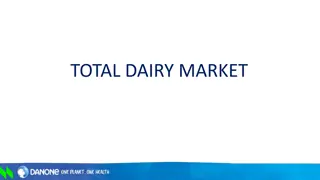Understanding Post-Parturient Haemoglobinuria in Dairy Cows
Post-Parturient Haemoglobinuria (PPH) is a metabolic disease affecting high-producing dairy cows after calving, characterized by hemolysis, hemoglobinuria, and anemia. Common in buffaloes and cows, it is caused by phosphorus deficiency in diet, affecting intracellular functions and leading to clinical signs like anorexia, drop in milk yield, and dark urine. Diagnosis involves measuring serum phosphorus levels, hemoglobin, and total erythrocyte count. Treatment includes addressing the underlying deficiency and managing clinical symptoms.
Download Presentation

Please find below an Image/Link to download the presentation.
The content on the website is provided AS IS for your information and personal use only. It may not be sold, licensed, or shared on other websites without obtaining consent from the author. Download presentation by click this link. If you encounter any issues during the download, it is possible that the publisher has removed the file from their server.
E N D
Presentation Transcript
POST-PARTURIENT HAEMOGLOBINRURIA(PPH) VCM-609 (Medicine) Asst. Professor Dr. Anil Kumar Dept. of VCC
Post-parturient Haemoglobinuria Synonyms: Hypophosphataemia/ Red Water disease/ Nutritional Haemoglobinuria It is a metabolic disease of high producing dairy cows occuring soon after calving (2-4 weeks after calving), is characterised by intravascular haemolysis, haemoglobinuria and profound anaemia. It May affect buffaloes before or after parturition Buffaloes are more susceptible than Cattle 3rd 6th calving cattle/cows are more susceptible. Etiology: Deficiency of Phosphorus in diet : a) Forages grown on Phosphorus Deficient soil: Natural Deficiency in soil. Constant removal by cropping. Leaching by rains.
Reduced availability due to extreme pH or high levels of AI, Fe,Ca, in soil. Drought conditions reduces P content in the forage b) Heavy feeding on hemolytic or oxidative plant toxins(e.g Brassica spp , sugar beets, or green forage)and plants low in P(cruciferous plants& Barseem) may predispose to the case c) Impaired absorption: Vitamin D Deficiency Improper Ca : P ratio Intestinal diseases diarrhoea Ruminal stasis / dysfunction d) Increased requirement of phosphorus : Heavy drain of P throudh milk ( 0.93 - 1 gm / kg ) in recently calved animals. Increased requirement for development of foetus during advance pregnancy.
d) Very cold drinking water Normal function of Phosphorous: Intracellular functions(Glycolysis, o2 transport, muscle contractions) Cell membrane from oxidative damage. Demineralization of bone Pathogenesis: Decreased Phosphorous Inhibit the Glycolytic Pathway of RBCs Decrease Glycolysis and ATP Synthesis Altered structural and functional changes, and increased fragility of RBCs Haemolysis and Haemoglobinuria
Clinical signs: Partial to complete anorexia Marked drop in milk yield Temperature usually normal but heart rate is increased Tachycardia, loud heart sounds Rapid breathing in early stage and dysponea (anoxic anoxia) in later stages secondary ketosis Light to dark coffee coloured urine Pale mucous membranes with Jaundice is seen in very late stage of disease Usually have firm and dry faeces Death occur due to anaemic anoxia
Clinical Pathology Serum level of P 0.5-1.5mg/dl(Normal 4-7mg/dl) Haemoglobin drop to 6-8 gm% (Normal 10-12 gm%) TEC drop to 2-3 millions/cumm of blood (Normal 5-8 millions /cumm of blood ) PCV drop to 2.5-15 (N= about 35) Serum bilirubin and BUN raised. Low Cu level of blood
Diagnosis: (I) History (II) Clinical signs (III) Laboratory diagnosis Quick response to replacement therapy of P Enlargement of liver & spleen Differential diagnosis:- Babesiosis Leptospirosis Bacillary haemoglobinuria(Clostridium haemolyticum) Treatment: a. Specific treatment Sodium acid phosphate (60g in 300 ml DW, IV, ) followed by S/C dose after 12 hr for 3-5 days, and also , oral dose (60 gm ) / daily / till 3 days after recovery
Inj. Ascorbic acid (Vit. C)@ 15 - 20 mg / kg IV daily for 2- 4 days can also be used. Ascorbic aid is antioxidant and hence it relives oxidatives stress on RBCs. Anti fibrinolytic drugs (Inj. Botropase 10 ml in 20 ml Normal Saline IV daily for 1 - 3 days) b. Supportive treatment: Blood transfusion in severe cases. A minimum of 5 L of blood to a 450 kg cow is recommended. This will usually suffice for up to 48 h by which time an additional transfusion may be necessary if the cow is weak and the mucous membranes pale. Fluid therapy for both supportive therapy and to minimize the danger of haemoglobinuric nephrosis Oral dosing with bone meal (120 g twice daily) or dicalcium phosphate or a suitable source of Ca & P daily for 5 days is recommended
Mineral mixtures @ 50 gm daily orally to maintain serum inorganic phosphorous levels. Haematinic like Feritas inj. during convalescence may be given Prevention & Control Mineral mixture @30-40gm/animal/day Preparation containing Ca, P & Vit. D Protect recently calved & advance pregnant animals from cold stress Do not have the access to kale, beets, turnips, alfa-alfa in excess while grazing in the pasture























